Making a Splash
August 11, 2018
My sailing narratives usually start with a fussy recounting of the weather forecast. There is a very good reason for this. Picking a day with the right winds is the single most important factor if you want a good day sailing on the rivers. The trouble is that picking that day is difficult, even with the advantages of modern weather forecasting. The forecasters are doing very well at a forecasting problem that is very, very hard. Their single "very" is often no match for "very, very." River sailors need to pay the most careful attention to this one factor if their efforts are to be rewarded with a great day's sailing.
It's now been two weeks since my first sailing day of the season. I've been watching the weather forecasts each day with disappointment. There's been no secure day for sailing. The winds have been Southwesterly. That is bad for my starting point at the Newport Marina a little over a mile downstream of the Point. Those winds are blocked by the high ridge of Mount Washington on the Southwestern bank of the river.
Today finally things looked better. The weather forecast was calling for gentle Northwesterly winds. They would blow along the course of the Ohio River and they would blow against the current. They would carry me easily up to the Point.
The winds forecast were in the weaker range: 3 to 6 mph, with little stronger gusts. However by late morning is was clear that stronger winds were blowing. Eve and I went to Cherry's diner downtown for breakfast. Walking home along Liberty Avenue just after midday, we could feel the breeze.
Here's the National Weather Service record for the day:
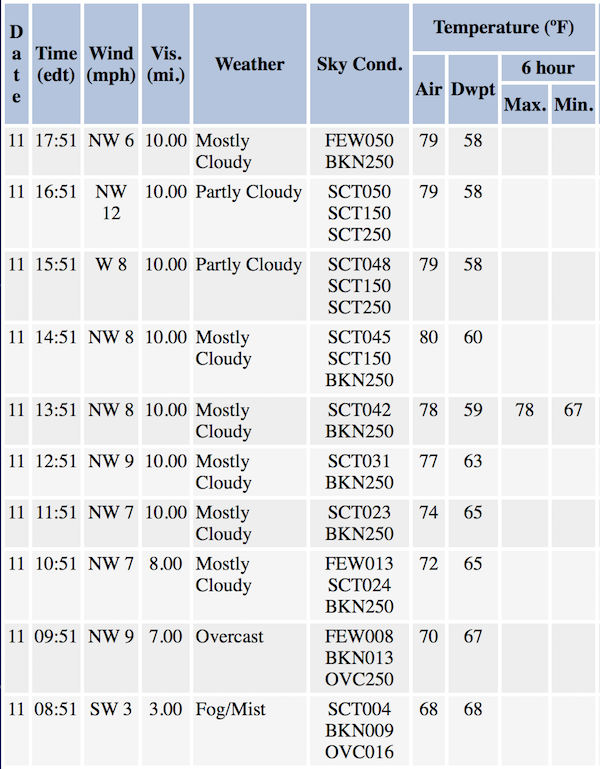
The latest report I could then see was for 11:51 am. It was showing Northwesterly winds of about 7 mph. As the afternoon progressed, they were building to Northwest winds at 8 mph.
This is perfect! So the decision was taken. Sail!
The other factor to be checked is the river currents. All I needed to see was the flow on the Ohio river:
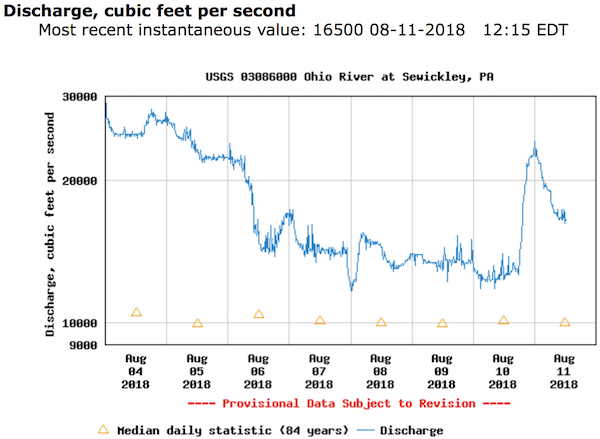
A modest 16,500 cubic feet per second is low enough for me not to need to check the flow on the Allegheny and Mon Rivers. (They combine to form the Ohio River flow.) This is a slight current I can easily beat, especially with winds blowing against the current.
Soon all the sailing gear was packed and we headed off. "We," since Eve decided to join me for the bike ride along the rivers to the marina. We crossed the Allegheny River at the bicycle lane on the 6th Street Bridge. (The bridge was closed to car traffic so we could use its whole width.)
My regular ritual of checking the wind began. There was none discernible on the bridge. Bad. Arriving on the Northern bank of the Allegheny River, I found a flag showing good wind from the West:
Good.
I've become an avid flag watche. It's a good way to see what wind is where. It's essential to do this since a forecast can say one thing about the winds, but quite another can still happen.
Riding along the Allegheny River, however, I found no wind at all. The fountain at the Point was indicating a good wind from roughly the West or Northwest.They weren't making it up the Allegheny River, however.
Winds were better at the Del Monte pier. I measured winds of about 6 mph from the West, roughly.
Arriving at the Point, I could see a line in the water. It marked the division between the more distant part of the river where the Northwesterly winds blew (rough water) from the nearer part that was sheltered by the Northern bank (glassy water):
Soon enough we arrived at the marina. Eve was not interested in the nuisances involved in setting up a sailboat. So she headed back home and I turned to the nuisances. Last season, after the older one had decayed, I'd made a long, narrow bag to protect the mast with the sail wrapped around it.
Alas, it was too narrow. On my last day's sailing, I had barely managed to extract the sail and mast from it and had struggled to get it back in a the end of the day.
So I'd gone home that day and soon made a larger bag:
The old bag was quite wet inside from recent rainfalls. That meant that it stuck to the sail. It defied all efforts to slide it off. I had to cut it off.
As I cut, I noticed one of the behemoths of the river powering past:
Before all this, I had checked the river conditions from the end of the marina. The winds were great. They were a steady 6-8 mph blowing upstream:
Gazing at debris in the water, I could not make out any discernible current. Excellent! This is as good as it gets!
Here's the boat ready to be rigged:
At 2:30 pm I put into the water. I'd be sailing on a run, that is, with the wind behind me. The Hobie Bravo's sail tends to flap about badly in those conditions. Since the winds were relatively strong, I "reefed" the sail. That is, I reduced its area by rolling a part around the mast:
It started very nicely. I made a healthy 5-6 mph towards the Point. But then, just a few hundred yards out, the wind faded and nearly died.
Oh dear--no wind!
This would be the story for much of the day's sailing. Whatever the winds might be doing at the weather station, they were not steady on the water. All day, I would alternate between periods of good winds and then calm.
Here's a graphical display of winds recorded by the National Weather Service in the earlier table:
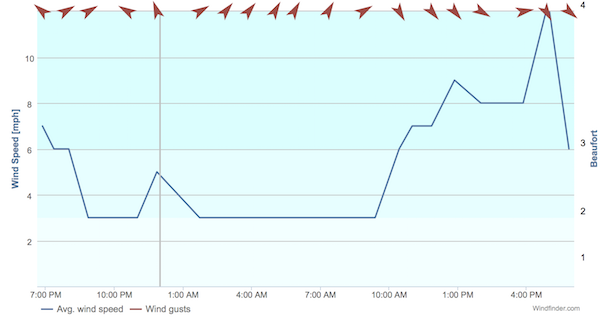
This graph makes the wind look strong and steady. It gives no sense of the coming and going of the wind, the periods of good wind and of little or no wind, during the afternoon
So it went. Here I looked back at the marina to take parting photo:
It turned out to be just the moment that winds returned. You can see that in the bubbling wake. By then I'd unreefed the sail. To avoid too much flapping, I decided to zig-zag across the wind. That would keep the sail fuller.
Here I am approaching the West End Bridge, with a full sail:
In stops and starts, I pass the Science Center:
The Point nears:
Since the wind is coming and going, I'm watching flags carefully. They reveal good winds at the Science Center submarine:
There's always something to look at. River life is definitely getting more interesting:
Getting closer to the Point:
There are plenty of kayakers enjoying the perfect weather:
The flag on Heinz Field reveals good winds blowing from the Northwest:
I use them to take me to the Point, arriving at 3 pm. There the winds die and I am becalmed.
You can see calm in the glassiness of the water's surface. There's nowhere to dock right at the Point.
In any case, I hadn't been in the water long enough to want to stop. Judged by the flags I could see, the winds on the Allegheny River seemed hospitable. So I turned my bows up that river. I passed in close to a bouy.
Soon I was approaching the Fort Duquesne Bridge, just as a large river boat came downstream:
Another buoy:
Progress slows after I've passed the Fort Duquesne Bridge. I'm starting to ask myself if I should turn back. I am sailing now on a "run" with the wind behind me. A rough rule of thumb I'd learned on the rivers is that it will take twice the time to return, tacking into these same winds.
But then the winds came back. You can see that in the flags on the ballpark:
Sailing is often gambling with the wind. So I gamble. Onward. I'm now approaching the 6th Street Bridge:
I'm aligned with the flags at the ballpark and they are showing steady winds.
A few moments later, the winds are gone and the same flags hang limply:
These signs should be heeded. I may not have enough wind to get home. At 3:30 pm, I decide to make the turn for home at the 6th Street Bridge:
Sailing back to the Point is first slow and tortured and then faster. This is easy to see in the gps track of the sail, color coded for speed:
My starting point is at the Newport Marina, circled in red. Since my course is convoluted, I've added arrows to indicate direction.
The sailing from the 6th Street Bridge back to the Fort Duquesne Bridge is halting, as shown by the wide mix of colors. Purple and blue are faster. Orange and red are slower. The red portions occupy only a small part of the track. But since I am not moving in them, that doesn't mean that I was there for only a small time.
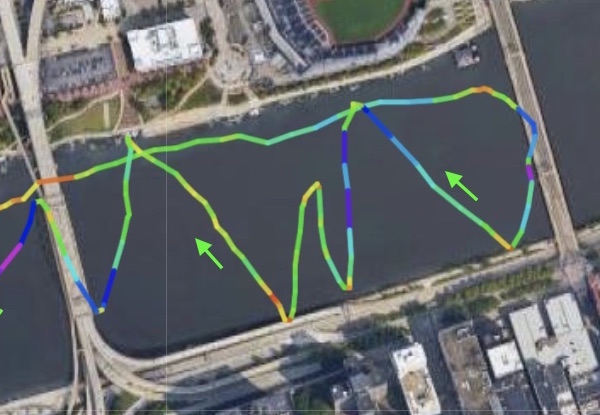
But then there's a fast passage to the Point.
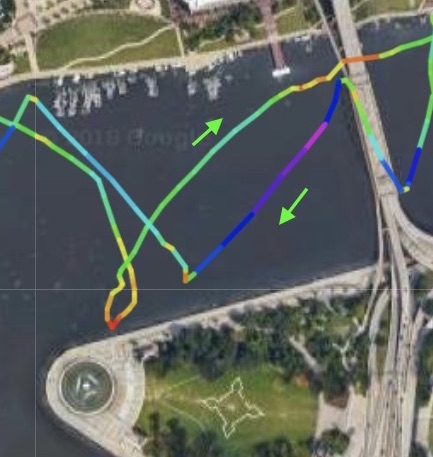
There I halt momentarily at 4 pm while a riverboat passes:
Now I start the sail homeward, into the wind. My good progress is visible in the strong, zig-zagged tacks down the river towards the West End Bridge.
There are huge barges parked on the river's edge. I sail in close to sense their immensity.
Approaching the West End Bridge, I decide to try a bold maneuver. Can I sail between the bridge pylons, shown in the blue circle below? Since the wind is blowing upstream, I would have to sail directly into the wind to get through the space between the pylons. Everything has to be just right or the winds will blow me into a pylon or back downstream. Can I manage the delicate maneuver?
Yes! Made it. Here I am emerging on the other side:
Passing the bridge means that I've left the "no wake" zone. This is the zone where powerboats are required not to raise big wakes during weekends and public holidays. The sign on the pylon says it all.
Of course that means that once powerboaters leave this zone, they hit the throttle and kick up a huge wake. These are the wakes that can scuttle a small boat. I cannot ignore them. The best course is to sail bow first into the waves. The boat is tossed about, but there's little danger of tipping.
It's usually impossible for me to correct course and get ready at the same time as I take photos. This time I managed. In the sequence of frames animated below, you see the powerboat zooming off, leaving sizeable waves in its wake. These waves soon reach my boat, which is tossed about by them.
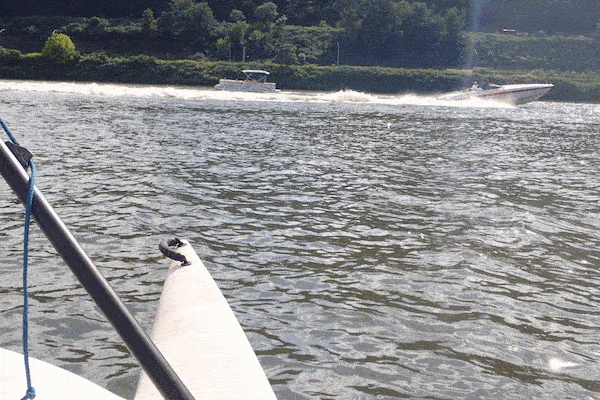
These powerboaters should or, worse, do realize the havoc their wake causes. But they do it anyway. It's like the guy who sits in a quiet park with a boom box. You had better like his taste in music since that is what you will hear.
I always have the same thought when I watch these powerboaters. He gets his speed and power cheaply. All he does is to push a throttle lever and hold on. There's no skill. There's no artistry to it. A little man with a big boat is still a little man.
I'm now approaching the Newport Marina and home. The view back to downtown is lovely.
It's now 4:30 pm and I am sore from the strain of sitting on a small, moving deck. Good sense would indicate it is time to stop. However I am having too much fun. The winds are steady and it is easy to add one more tack and then another. Then I see a powerboat near the marina. I think they might be docking. I'd need to wait for them to dock before I could sail in.
So I decide to sail on past the marina towards Brunot's Island, which is farther downstream on the Ohio River. The winds are holding steady and I'm sailing at 4-5 mph, which is both a restful and interesting speed. I can now see marinas from the water that I usually only see from the river trail:
Here's the upstream tip of Brunot's Island.
Closer:
I arrive at the tip at around 4:45pm and decide to head home.
Around then, I spot a barge approaching, as it passes under the West End Bridge:
The barge is far away and barely visible in the photo, even though I have zoomed in on it. However I know that a barge moves quickly and it soon will be upon me. The real question is which way will it go? How do I avoid its huge bows?
The river divides at Brunot's Island so it could go into either the Western or Eastern channel.
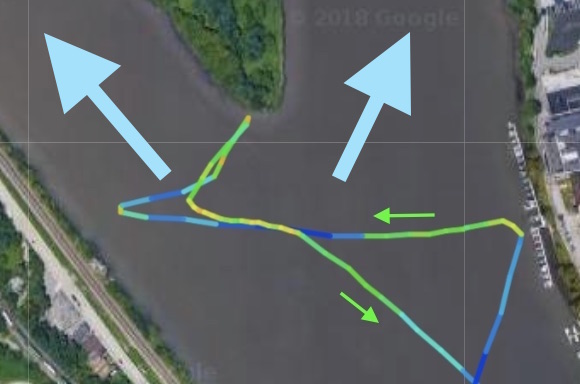
I keep a careful eye on the barge, while sailing within the Western channel. During this maneuvering, I get very close to the upstream tip of the island.
My recollection is that the barges take the other, Eastern channel. I'm fairly sure of it, but not willing to bet my life on it. As the barge nears, I can see more of its side. That is promising. As long as you can see the side of the barge, it is not heading directly for you.
I was correct. The barge is heading for the other, Eastern channel. I watch it pass from a safe distance.
All that remains is a gentle sail back to the marina. My bows strike the ramp at 5:05 pm. I jump off the deck and can stretch sore muscles. My day's sailing is over.
It's time to unrig the boat and stow it away, to await the next day of sailing. My new sail and mast bag is a very loose fit. That is good. It makes it very easy to slide the bag over the mast.
John D. Norton
Back to main
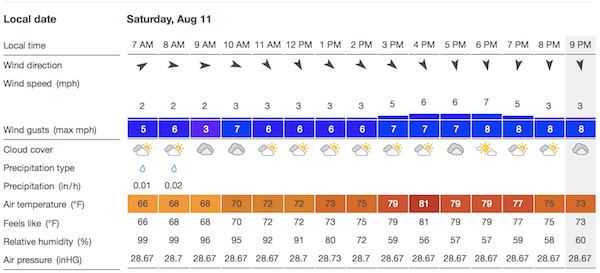 click
for larger
click
for larger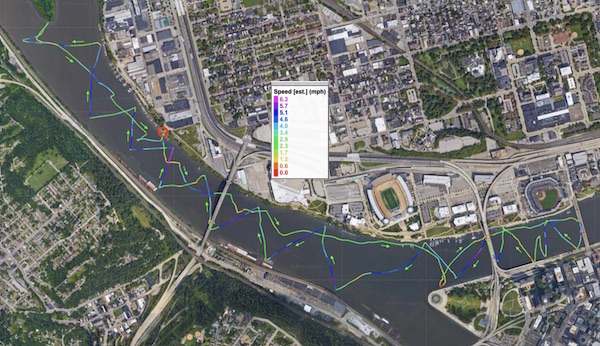 click
for larger
click
for larger